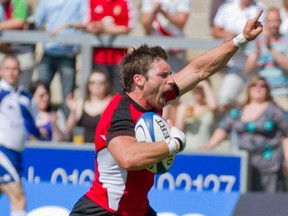The world awaits for Canada's rugby team

Article content
SURREY, England — This happens before every Canadian international rugby match. It is the same unspoiled calm of men about to smash their bodies. It is just a different bus in a different part of the world. There is little sound and little light, only wisps of the setting sun creep through tinted windows. All the players are wearing black tracksuits. Some are wearing headphones. Some are twitching. Some are thinking about rugby. Some are not thinking anything.
about now. He plays the No. 8 position and must explode into every pile of muscle to find the oval ball and get his offence moving. He needs to be a time bomb.
He stares out the front window. The work of his team over the past four days has led to this Wednesday night drive down Molesey Road in Surrey, England, to Esher Rugby Club for a Churchill Cup match between Canada and Russia. Metaphorically, this street stretches further. It reaches down to the southern hemisphere to New Zealand and the 2011 Rugby World Cup. Carpenter will not admit he can see that far, but he can. All his teammates can.
This journey started in France in 2007, seconds after Australia beat Canada 37-6 in Canada’s final match of the last World Cup. It was the team’s worst showing in the biggest tournament — winless at the bottom of its group. The players on this bus who played then sigh before they remember: The second-half collapse against Wales (42-17); the poor decisions in the loss to Fiji (29-16); the pain of conceding a last-second try to Japan (12-12).
The same men strangely have trouble finding the words to describe the feeling of playing in front of the world and measuring themselves against stronger men. Some stammer. The younger players hesitate too. No one has been picked yet for September’s 30-man squad.
But Jason Marshall gives a little away.
“If I make this World Cup, I will have proven something to myself,” the 26-year-old says.
Marshall went 0-22-2 as the starting quarterback for Simon Fraser University from 2005-07. He devoted himself to rugby in 2008 and, after a conversation with Canadian coaches, filled his chiselled 6-foot-3, 220-pound frame to become a 255-pound behemoth to play prop, a lineman-like position that requires passing and kicking skills. His teammates call him Meat.
“I put the work in,” Marshall says.
Every player wants his efforts to impress Canadian head coach Kieran Crowley. He sits up front. The soft-spoken New Zealander played for the All Blacks from 1983-91 and won the 1987 World Cup. He became Canada’s head coach in 2008 and is hard man to read. The 49-year-old says the players are only custodians of the Canadian jersey.
“After 80 minutes he comes back in and he gives the jersey back and he has to earn it again,” Crowley says.
So the players talk only about the next game, the next pass, the next kick, the next try — the little things. Anything beyond is nebulous.
***
Rugby is perhaps the toughest sport. It is a rigourous test of the mental and physical abilities of fifteen players. No pads. No helmets. No timeouts. A match is an 80-minute collision between chess and physics. The best identify mismatches and attack open space. The rest are overwhelmed and left hurting.
Canadian rugby has never been flashy, but it has always been committed. Superhero-sized men like Al Charron, Rod Snow and Jon Thiel tucked the ball, dropped their chins and slammed into walls of men again and again and again. That relentless power pushed Canada to the 1991 World Cup quarter-finals, and to at least one victory in every World Cup until 2007.
But since rugby union became professional in 1995 — like its faster cousin rugby league — the top nations started professional leagues and the top players learned to quickly stitch together elaborate running lines and perfect spin passes. Canada remained amateur and by the 2007 World Cup the chasm was huge. Canada grunted to a 17-9 lead over Wales in the beginning of the second half, before key Welsh substitutions exposed Canada naïveté.
“We didn’t move the ball,” says Geraint John, who is a surviving coach from 2007.
It was a turning point. Crowley arrived and immediately began educating Canadians about the myriad possibilities when they started moving the ball.
“Players have to be challenged so they make mistakes and learn. It gives them the confidence to run and pass under pressure,” Crowley says.
Immediately, there were tough losses to Scotland, Ireland and Japan, but subsidies from the International Rugby Board and Sport Canada were channelled to centralize development in British Columbia, Canada’s rugby heartland. There is still no professional league, but there is a professional training atmosphere. Food is measured, training is regimented and players get stronger.
“The boys call me Benjamin Button,” says team captain Pat Riordan.The 31-year-old has represented Canada 33 times in international test matches and is still achieving new fitness scores even after recovering from upper body nerve damage sustained in a game in 2008.
A re-emergence of Canada rugby possibilities began at the 2010 Churchill Cup, the annual tournament used to give the United States and Canada high-level competition. It ends after this year. Canada trounced Uruguay 48-6 then beat France ‘A’ 33-27 before losing in the final to the England Saxons 38-18.
France led 27-26 in the 70th minute when Canada stole the ball pushed the length of the field to score a try.
“Beating France or beating any team is not winning the lottery. It’s earning a pay cheque,” Riordan says.
Crowley and his coaching staff constantly show their players video analysis and emphasize that Canada should always take less than 10 penalties, complete 90% of tackles and keep the ball in 90% of scrums and line-outs. Most players huddle around laptops screen on their free time looking for ways to earn every percentage point.
“Self-teaching is important,” Crowley says.
“It’s about thinking we can win,” Riordan says. “It’s about affecting the process.”
***
Four days ago Italy ‘A’ could not keep up with Canada, especially not the gallop of flanker Chauncey O’Toole. A flanker is a big man required to be both forceful and adroit and the native of Belle Isle, N.B., cleverly rambled through the Italians with his rhinoceros legs. In the 56th minute, he ran free again but was aware enough to pass to fullback James Pritchard, who darted through the trailing mass of blue jerseys and easily scored to seal a 26-12 win.
“Things moved really quickly and we just reacted,” O’Toole said after he was named man of the match.
This night against Russia is different. Canada, ranked 15th in the world, keeps dropping passes. Crowley made several changes to the team so he can continue to grade all his players. Everyone is grasping the ball like a bar of soap.
The 20th-ranked Russians capitalize and take an 18-15 lead into halftime.
“We were playing horrible rugby,” Ander Monro says later. The 29-year-old plays flyhalf, a quarterback-like position, and is captain tonight. He is a slim Scotsman who was born in Toronto and returned to Canada to play international rugby in 2006.
Monro has a smooth British accent and loves maxims. “Rugby doesn’t build character, it reveals it,” he says.
Passes are tighter in the second half. Canadians run in every direction to create confusion, and in the 61st minute an arrangement of quick passes releases Monro and three others on the right side. Three more passes and Monro dives for a try. Then O’Toole scores. By the end, Canada scores 19 unanswered points and wins 34-19.
“A bunch of times Canada used to lose games making that many mistakes,” Crowley says. “So it is pleasing that they’re starting to learn how to play for 80 minutes.”
It means a second Churchill Cup final is another chance to learn, and another chance for players to impress for the right to play in bigger tests.
In September, Canada is in a round-robin group with Tonga (ranked 16th), Japan (13th), France (sixth) and New Zealand (the world No.1). Only the top two advance to the quarter-finals and the third team automatically qualifies for the 2015 World Cup . Canada aims to finish third — an adjustment to the definition of victory. The top nations are just too powerful.
But what happens after this World Cup?
There is hope for the 2015 tournament. Crowley has signed an extension to remain as head coach through 2013 and has submitted a long-term squad list including Marshall and O’Toole, who will be in their prime in four years.
But few will commit.
The players who are age 23, 24 and 25 desperately want to play for Canada. But playing international rugby is a burden. Only a half-dozen on this team play professionally. Another 16 receive a small tax-free stipend from Sport Canada. And the rest either work or go to school full-time.
“Canada does not have a professional environment,” Crowley says. “But the sacrifice the players make for rugby makes them professional.”
O’Toole moved to British Columbia four years ago to train, travel and play. He had a trial with a top European team in September, but he was quickly released. Most Canadians find it hard breaking into club teams in Europe because many countries want only to develop native players.
“I can’t say I’m going to hang around for four more years or I’m not going to hang around for four more years,” O’Toole says.
Rugby Canada is trying to negotiate with clubs and countries to get Canadians playing more professional games. Canada only plays six to seven international tests a year and Crowley says his team needs more.
Rugby Canada CEO Graham Brown will not lie to the players and promise European opportunities or a future North American league. After this World Cup, some players will leave. Then the hard work will begin again.
“We also recognize at some point our athletes need to move on with their lives,” Brown says.
Right now, though, the 22 men (15 starters and seven substitutes) who will take custody of a Canadian jersey in Saturday’s Churchill Cup final have one purpose.
“The World Cup,” O’Toole says with a smile, “is the best place to test yourself. It is playing for your country at the pinnacle of the sport.”
• Email: mscianitti@nationalpost.com | Twitter: @mscianittiCheck out our sports section for the latest news and analysis.










